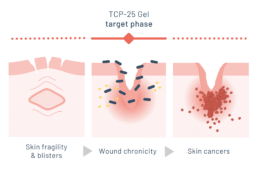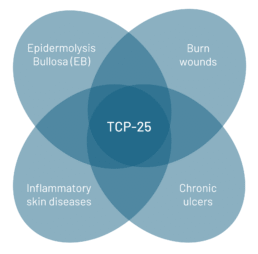Impact
HELPING THOSE WHO HURT THE MOST
Epidermolysis bullosa (EB) is a group of rare genetic, severe and life-threatening diseases with fragile skin and mucous membranes, manifested as skin blistering, erosion, and ulceration associated with severe pain. There is a significant unmet medical need in patients suffering from EB and the condition has been described as “the worst disease you never heard of”.
With skin as fragile as a butterfly’s wings, patients with EB are often called butterfly children. They have a lifelong challenge of extremely fragile skin and mucous membranes that easily blister and tear from mechanical friction or trauma. The skin is chronically inflamed and wounds are frequently super-colonized. A long-term consequence of non-healing, chronically inflamed and infected wounds is an increased risk of developing skin cancer (cutaneous squamous cell carcinoma).
The need:
- 500,000+ people worldwide live with EB
- No curative treatments
- High burden on patients and caregivers
TCP-25 is tailored to:
- Dampening the harmful excessive inflammation
- Treat and prevent infections
- Reduce exudation (wound fluid)
- Improve wound closure
- Improve quality of life

Beyond EB
TCP-25 also has the potential to address a range of other skin conditions, which collectively account for millions of deaths worldwide each year and nearly 4% of total healthcare costs.
Damage to the skin barrier imposes a risk of infection and excessive inflammation, and severe wounds require treatment. Current treatments are not optimal and may increase the threat of antimicrobial resistance (AMR). New efficient treatments are needed that address both harmful inflammation and infection.
Venous leg ulcer (VLU) and acute burn wounds are examples of difficult to heal wounds that would greatly benefit from better treatment options.


